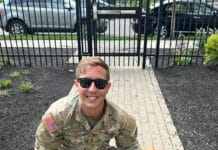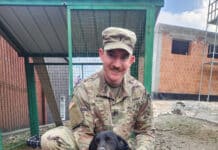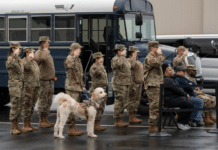WASHINGTON, D.C. — The U.S. Department of Veterans Affairs (VA), as part of its comprehensive examination of more than 55 million death records from 1979-2015, released data today from its analysis of Veteran suicide data for all 50 states and the District of Columbia. The data yield several important findings:
The average number of Veterans who died by suicide each day remained unchanged at 20.
The suicide rate among Veterans who have not recently received Veterans Health
Administration (VHA) services is higher than the rate among Veterans who have recently used VHA services. Of the 20 veterans dying by suicide each day, 6 recently used VHA services, while 14 did not.
- Veterans ages 18-34 had the highest suicide rates while veterans ages 55-74 had the highest number of suicides.
- More Veterans are receiving VA benefits and health services than in past years.
The data underscore suicide is not explained by any single cause – as reflected in recently released data from the Centers for Disease Control and Prevention – but instead a range of factors beyond mental health conditions alone—including relationship, substance use, physical health, job, financial, and legal problems. Additionally, the data show that of the 20 Veterans who die a day, 14 are not using VHA services so we must ensure private sector health systems as well as non-clinical settings including schools, workplaces, and places of worship, play a role in increasing positive and supportive social relationships and community connections to shield the effects of risk factors in Veteran’s lives.
Overall the VA data underscore the need for more coordinated, community-based approaches to reach all people—including Veterans— so to provide care and support well before issues reach a crisis point.
According to the National Action Alliance for Suicide Prevention’s (Action Alliance) 2012 National Strategy for Suicide Prevention (NSSP), developed in collaboration with the Office of the U.S. Surgeon General, community-based programs, policies, and services play an integral role in suicide prevention. A combination of individual, family, community, and societal factors influence suicidal behavior.
Therefore, efforts to prevent suicide are more likely to succeed if they follow a comprehensive approach—one that involves health care systems, including the VA, and community-based settings.
“Veteran suicide cannot be addressed solely by the VA but instead it requires a comprehensive approach between the VA and communities across the U.S. to identify those veterans and non-veterans who are struggling or in crisis,” said Dr. Carolyn Clancy, Public Co-Chair of the Action Alliance and Executive in Charge for the U.S. Veterans Health Administration.
The data reinforce the VA’s strategy of employing a public health approach – which uses science to address multiple risk factors for suicide and prevent suicidal thoughts and behaviors from occurring – to prevent suicide, which aims to work with various partners to expand the network of support for veterans.
“The Action Alliance, the nation’s public-private partnership for suicide prevention, is committed to supporting veterans, regardless of whether they are seeking care in the VA in their home communities,” said Bob Turner, Private Sector Co-Chair of the Action Alliance and Senior Vice President (Retired) of the Union Pacific Corporation. “We must work collectively, across all sectors whether that be military, rail, public or private, if we want to end the tragedy of suicide among individuals who are suffering – and the ripple effect it has on families, friends, and communities,”
While VA is most suited to serve veterans who touch their systems, it is up to all of us to make sure every door is the right door for a veteran in need of support. The data show that veterans who have not recently received VHA services is increasing faster than the rate among Veterans who have recently used VHA services.
Thus we must identify and connect those veterans not seeking VHA care – or any other supports—with the care they need and deserve. A comprehensive approach between the VA, its partners, and communities nationwide has the potential to save more lives and connect veterans to care.
VA has implemented significant suicide prevention efforts in the years since these data were captured, including expanding the Veterans Crisis Line and launching SAVE online training.
In addition, VA is teaming up with the Department of Defense and Department of Homeland Security on a Joint Action Plan to support service members in their first year of transition after military service.
VA also plans to release the National Strategy for Preventing Veteran Suicide, a new strategic framework for Veteran suicide prevention, which leverages the public health approach, and aligns to the 2012 National Strategy and DoD Strategy.
The Action Alliance applauds these efforts along with the VHA’s ongoing commitment to work in close partnership with national and community partners to address the public health problem of suicide through a comprehensive approach that promotes health, healing, and recovery.
While the VA has done much to advance suicide prevention to better support veterans who might be in distress or in crisis, the data shows that other partners must be involved if we want to see a reduction of suicide in the U.S. Investments in research that improve understanding of other diseases and conditions, and effective approaches to prevention and treatment have reduced mortality rates in other leading causes of death.
The same investments, resources, and attention – by both public and private partners – must be dedicated to suicide prevention.
Resources for supporting Veterans include:
- Veterans Crisis Line – (1-800-273-8255; Press 1) Chat online at VeteransCrisisLine.net or text to 838255. Resource offering 24/7 access to a skilled, trained counselor at a crisis center. This crisis line also serves active duty military.
- Make The Connection – An online resource designed to connect Veterans, their family members and friends, and other supporters with information, resources, and solutions to issues affecting their lives.
- SAVE Online Training – In collaboration with PsychArmor Institute, VA has developed a free online SAVE training, which is designed to equip anyone who interacts with Veterans to demonstrate care, support and compassion when talking with a Veteran who could be at risk for suicide.
- Tragedy Assistance Program for Survivors (TAPS) – TAPS offers care to those grieving the death of a loved one serving in the U.S. Armed Forces. Established in 1994, TAPS operates 24 hours a day, seven days a week through a national peer support network and provides connection to grief resources, all at no cost to surviving families and loved ones.
- Wounded Warrior Project’s Combat Stress Recovery Program – The Combat Stress Recovery Program (CSRP) addresses the mental health and cognitive needs of warriors returning from
war. CSRP provides military rehabilitation services at key stages during a warrior’s readjustment process. - VA/DOD Clinical Practice Guideline for Assessment and Management of Patients at Risk for Suicide – These comprehensive guidelines outline a framework for structured assessment of adults suspected to be at risk of suicide and the immediate and long-term management and treatment that should follow if an individual is found to be at risk.
- Give an Hour – Give an Hour’s mission is to develop national networks of volunteers capable of responding to both acute and chronic conditions that arise within our society, beginning with the mental health needs of those who serve and their families. They are a nonprofit organization providing free mental health services to US military personnel and families affected by the conflicts in Iraq and Afghanistan.
While this statement has a focus on veterans, there are also a variety of resources available for active duty military. Please note key resources for those currently serving in the armed services:
- Defense Suicide Prevention Office (DSPO) – DSPO provides advocacy, program oversight, and policy for Department of Defense suicide prevention, intervention, and postvention efforts to reduce suicidal behaviors in Service members, civilians and their families.
Finally, for anybody who is in crisis or distress, we encourage calling the 24/7, free, and confidential National Suicide Prevention Lifeline: 800-273-TALK (8255).
This VA’s report provides a renewed call to action to address suicide in among our nation’s veterans and among all Americans, recognizing that for every one person who tragically dies by suicide in the U.S., there are approximately 278 people who have experienced serious thoughts about killing themselves, and nearly 60 who have survived a suicide attempt, the overwhelming maj majority of whom will go on to live out their lives. These untold stories of hope and recovery are the stories of suicide prevention, stories which are informing the Action Alliance’s efforts to prevent more suicides every day.
The statement was crafted by partners from public and private sectors. Private sector partners include:
American Association of Suicidology
American Foundation for Suicide Prevention
Education Development Center, Inc.
Entertainment Industries Council, Inc.
Suicide Awareness of Voices of Education
Suicide Prevention Resource Center
National Suicide Prevention Lifeline
The Trevor Project
Tragedy Assistance Program For Survivors
FOR MEDIA PARTNERS:
Research shows that the media may influence suicide rates by the way they report on suicide. Evidence suggests that when the media tell stories of people positively coping in suicidal moments, more suicides can be prevented. We urge all members of the media working on these stories to refer to the Recommendations for Reporting on Suicide for best practices for safely and accurately reporting on suicide (such as including the National Suicide Prevention Lifeline 800-273-TALK [8255]). For stories of persons with lived experience of suicidality and finding hope, refer to www.lifelineforattemptsurvivors.org.
NATIONAL ACTION ALLIANCE FOR SUICIDE PREVENTION:
The National Action Alliance for Suicide Prevention is the public-private partnership working to advance the National Strategy for Suicide Prevention and make suicide prevention a national priority. The Substance Abuse and Mental Health Services Administration provides funding to EDC to operate and manage the Secretariat for the Action Alliance, which was launched in 2010. Learn more at actionallianceforsuicideprevention.org and join the conversation on suicide prevention by following the Action Alliance on Facebook, Twitter, and YouTube.
All content herein is owned by author exclusively. Expressed opinions are NOT necessarily the views of VNR, authors, affiliates, advertisers, sponsors, partners, technicians, or VT Network. Some content may be satirical in nature.
All images within are full responsibility of the author and NOT VNR.
Read Full Policy Notice - Comment Policy
































